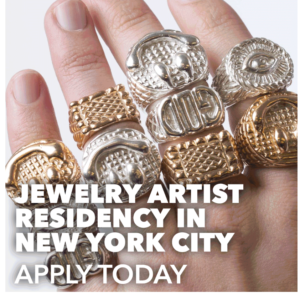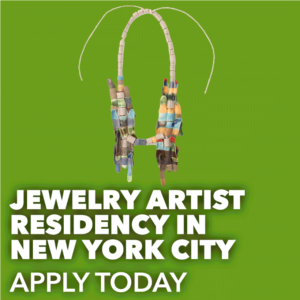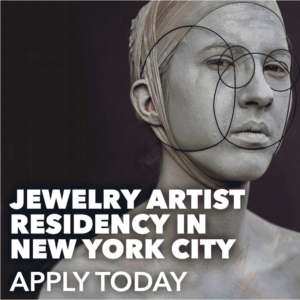Episode 153
What you’ll learn in this episode:
- How Jonathan moved from sculpture to jewelry to drawing, and why he explores different ideas with each medium
- How the relationship between craft and fine art has evolved over the years
- Why people became more interested in jewelry during the pandemic
- Why jewelers working in any style benefit from strong technical skills
- How you can take advantage of the 92nd Street Y’s jewelry programming and virtual talks
About Jonathan Wahl
Jonathan Wahl joined 92nd Street Y in July 1999 as director of the jewelry and metalsmithing program in 92Y’s School of the Arts, the largest program of its kind in the nation. He is responsible for developing and overseeing the curriculum, which offers more than 60 classes weekly and 15 visiting artists annually. Jonathan is also responsible for hiring and supervising 25 faculty members, maintaining four state-of-the-art jewelry and metalsmithing studios, and promoting the department locally and nationally as a jewelry resource center.
Named one of the top 10 jewelers to watch by W Jewelry in 2006, Jonathan is an accomplished artist who, from 1994 to 1995, served as artist-in-residence at Hochschule Der Kunst in Berlin, Germany. He has shown his work in the exhibitions Day Job (The Drawing Center), Liquid Lines (Museum of Fine Arts Houston), The Jet Drawings (Sienna Gallery, Lenox MA, and SOFA New York), Formed to Function (John Michael Kohler Arts Center), Defining Craft (American Craft Museum), Markers in Contemporary Metal (Samuel Dorsky Museum of Art), Transfigurations: 9 Contemporary Metalsmiths (University of Akron and tour), and Contemporary Craft (New York State Museum).
Jonathan was awarded the Louis Comfort Tiffany Emerging Artist Fellowship from the Louis Comfort Tiffany Foundation, two New York Foundation for the Arts Fellowships in recognition of “Outstanding Artwork,” and the Pennsylvania Society of Goldsmiths Award for “Outstanding Achievement.” As part of the permanent collections of The Metropolitan Museum of Art in New York, The Museum of Fine Arts in Houston, TX, and The Museum of Arts and Design in New York, his work has been reviewed by Art in America (June, 2000), The New York Times (June 2005), and Metalsmith Magazine (1996, 1999, 2000 2002, 2005, 2009); his work was also featured in Metalsmith Magazine’s prestigious “Exhibition in Print” (1994 and 1999). Jonathan’s art work can be seen at Sienna Gallery in Lenox, Massachusetts, which specializes in contemporary American and European art work, and De Vera in Soho, New York. His work can also be seen in the publications The Jet Drawings (Sienna Press, 2008), and in three collections by Lark Books: 1,000 Rings, 500 Enameled Objects and 500 Metal Vessels.
Before joining 92Y, Jonathan was, first, director of the jewelry and metalsmithing department at the YMCA’s Craft Students League, and later assistant director of the League itself. Mr. Wahl holds a B.F.A. in jewelry and metalsmithing from Temple University’s Tyler School of Art and an M.F.A. in metalsmithing and fine arts from the State University of New York at New Paltz. He is a member of the Society of North America Goldsmiths.
Additional Resources:
- Website: www.jonathanwahl.com
- Website: www.92y.org/jewelry
- LinkedIn: www.linkedin.com/in/jonathancwahl
- Instagram: @jonathancwahl/
Photos:





Transcript:
With more than 60 jewelry classes offered weekly, the 92nd Street Y’s Jewelry Center is by far the largest program of its kind in the country—and it’s all run by award-winning sculptor, jeweler and artist Jonathan Wahl. He joined the Jewelry Journey Podcast to talk about the different relationships he has with jewelry and sculpture; why craftsmanship should be embraced by the art world; and what he has planned for 92Y in 2022. Read the episode transcript here.
Interview with Jonathan Wahl
4/3/22
Sharon: Welcome to the Jewelry Journey Podcast. Today, my guest is Jonathan Wahl, Director of the Jewelry Center at the 92nd Street Y in New York. Jonathan was recently on the podcast, but we had to rush through the description of the many jewelry programs that are going on at the Y. So, I asked him back to tell us about the programs in more detail. Many of them are online and are recorded, so it doesn’t matter where you are in the world. Jonathan, nice to see you again.
Jonathan: Nice to see you, Sharon. Thanks for having me back.
Sharon: You ran through it very quickly at the end because I didn’t realize how much you had to say basically. So, tell us first about your interviews you have with sculptors and jewelers. Tell us about those. Are there any upcoming? Who are the next ones? Give us–
Jonathan: Sure, so the lecture series came out of the pandemic obviously. I think I’ve done about 25 or 30 lectures or interviews so far. The most recent series was a series of three talks about female sculptors who are jewelers or jewelers who are sculptors. As you could tell from our last conversation, I’m really interested in this line be-tween the fields of art, particularly between jewelry and sculpture or fine art and decorative art. So, I was really curious to talk to these three in particular New Yorkers who practice in both fields and it was Joe Platner who is a longtime jeweler in New York City, Michelle Okeldoner(?) whose work was primarily sculpture and also does jewelry and Anna Corey whose work also started in sculpture, but now is primarily a jeweler. So, it was really fascinating to talk to these women artists about how they practice and what inspires them in their practice.
Sharon: And do you have series upcoming more in the spring or summer?
Jonathan: Yup, I’m working on a series about enamel. Enameling seems to be having a re-surgence in our department and I think in jewelry in general, we’re seeing a lot more enamel and a lot more color in metals. So, it will be with a contemporary artist, a historical collection and a contemporary fine jeweler.
Sharon: It sounds very interesting and enamel, at least in the view I see now, is becoming much more popular.
Jonathan: Yeah, yeah, I’m not exactly sure why. I’m really curious. I think maybe it’s happy; it’s colorful; it’s as close to painting, I guess, as you can get in jewelry in a way.
Sharon: It’s such a skill if you do it right. It’s an artistry. Jewelry is an art, but it’s such an artistry within the art in a sense.
Jonathan: Absolutely, you can, as we say, shake and bake and get color on metal pretty easily. So, you can get pretty direct results and get color on your metal pretty simply. Of course, to be an expert enamellist, to practice grisaille or cloisonne or brioche, you need to become master craftsman. So, there’s a lot to dig into.
Sharon: So, do we need to keep our eyes on the spring session, the summer session or when?
Jonathan: It’s going to be the summer session. I think it’s going to take place in June.
Sharon: O.K., I look forward to it.
Jonathan: I’m not sure of the dates, but it’s coming and you’ll see it. Most of the talks so far are on our archives at 92Y.org in the jewelry center page.
Sharon: Yeah, I know there are some that I’d really like to go look at that I missed.
Jonathan: The previous three were with three Brazilian jewelers.
Sharon: Now, you just had an interview with—I don’t know how to say her last name—but she was talking about a Brazilian jeweler, Roberto Burle Marks.
Jonathan: Uhum, correct.
Sharon: But that was separate.
Jonathan: It was part of the Brazilian series because Roberto Burle Marks was a Brazilian.
Sharon: But it wasn’t part of the Sculpture and Artist Series; it was a different series.
Jonathan: Correct, right, they were three and three.
Sharon: There’s a lot going on. So, tell us about this jewelry residency. I was just looking at your Instagram and the ads for it. So, tell us about it.
Jonathan: The Jewelry Residency Program, it would be its fifth year, but we took two years off because of the pandemic. The Jewelry Residence Program is something that I’ve always dreamed of doing and I’m so happy that it’s back on. What it provides is a studio apartment here in our facility, 24-hour access to one of our studios and air-fare to and from New York City from anywhere in the world.
Sharon: Are people applying now? When does it start?
Jonathan: Yes, the applications are open until April 15. We extended the deadline.
Sharon: Does it start in September–
Jonathan: Sorry, it’s August 18-September 19, if I’m not mistaken. That’s the residency program.
Sharon: And you get applications from all over the world or what?
Jonathan: We had applications from fifty countries in 2019. I would love to have applications from farther afield. Most of them come from western Europe. We’re still trying to figure out how we reach populations in Asia or sub-Saharan Africa or Africa in gen-eral or even more in South America. It’s been kind of hard to get to some of those areas. I’m working on a trip to Korea which you know about, so I sent it to all the artists that we’re going to visit in Korea. So, I hope we get some applications from Korea and I also just was in contact with an artist who’s a Ukrainian jeweler and she has started on Facebook to try and raise money and funds and help Ukrainian jewel-ers who’ve been displaced, so of course I’ve shared that residency with her and the opportunity. We would love to support a Ukrainian jeweler and have them here in New York City for a month, particularly if they’re not in a studio, but I’m also looking forward to seeing how we can support a Ukrainian jeweler in general if they are here in New York City.
Sharon: And so it doesn’t matter, a male, female, anybody in between.
Jonathan: It doesn’t matter and it is open to Americans. It is an international jewelry resi-dency, but you are welcome to apply as an American. The reason for the residency is, as I mentioned, to expand New York City’s access to jewelers who don’t maybe normally get here and the type of work that isn’t often shown in New York City, but it’s also for an artist who might not normally be able to come to New York City to come to New York City, but it’s also about why an artist needs to be in New York, what would New York City do for them and that could be for a whole host of reasons and there is a jury panel that I assemble every year that helps me decide who that next person should be.
Sharon: Wow! That sounds pretty competitive, but it’s sounds really worthwhile.
Jonathan: Well, there’s only one spot. Sharon, with funding, we could expand that. So again, if anyone wants to help support a residence. The residency program, I’m completely open to a conversation.
Sharon: Well, I will suggest that people get in touch with you, O.K., or at least send the checks. O.K., so tell us about the travel program to Korea.
Jonathan: I do a trip every other year to somewhere in the world and we have gone to Israel, Italy, Austria, the Czech Republic, India, Japan and this year hopefully to Korea.
Sharon: Wow! That really sounds fabulous.
Jonathan: Yeah, the trips are centered around historical collections and contemporary jewelers and if you’re not familiar with the Korean jewelry scene, it’s really vibrant and really robust. It has its roots in Europe and the United States as well as with Korean tradi-tion. So, I’m really excited to meet these artists who blend a lot of techniques and traditions and they’re doing some really extraordinary work.
Sharon: Well, the Korean artists who have exhibited at the international shows have really been creative and really amazing.
Jonathan: Really strong work, yeah.
Sharon: So, the last I talked to you, I just wanted to double check. Are you still thinking you’ll be going October 6, whenever?
Jonathan: Yeah, that’s the tentative plan. The one thing. Korea has lifted quarantine restric-tions which is great, but groups are still restricted to six or fewer, so it’s a bit of a problem for our group which is about fifteen people. So, I’m a little bit on edge about that. I’m waiting to see if that will change.
Sharon: Wow! Six or fewer, that’s pretty–
Jonathan: That would make going out to dinner a problem and just going to into groups and staggering them, it’s like taking two trips frankly.
Sharon: Yeah, no, it sounds like a lot of logistics.
Jonathan: With that being said, I have a trip to the southwest in the wings for the end of October. If for some reason the gods are not with us to go to Korea, I’m putting together a trip to San Jose and Taos.
Sharon: There’s lots to see there.
Jonathan: Uhum.
Sharon: So, you also have a program for highschoolers to teach them about the jewelry industry. Tell us about that.
Jonathan: Yeah, this is certainly a program that’s been a dream of mine for a long time. It is a program that is offered to Title 1 art and design school in New York City and Title One schools tend to service underserve populations in general in New York City and most of those students wouldn’t normally get access to a jewelry studio in high school. Most kids don’t get access to a jewelry studio in high school in general. Particularly this population most likely wouldn’t be taking a class at the 92nd Street Y as a fee-for-service program for obvious reasons. So, this is a program to get kids who would normally be in the studio into the studio and expose them to the tech-niques and materials and offer them a view into a possible career path, if that’s something they would like to pursue. We’re coordinating with New York City Jewel-ry Week who has organized wonderful guest speakers with these kids and with NYCJWM and the Department of Education, are able to offer paid internships this summer which is really exciting. It’s the first year of this program, so we’re still find-ing our footing and I know there are going to be some kids who decide to go into the next year and I think particularly the juniors and seniors will hopefully take advan-tage of some of these opportunities and perhaps go deeper into the field.
Sharon: It sounds like a great opportunity, yeah.
Jonathan: Even master soldering to a teenager, regardless of whether or not you go into the field as a career, it’s a great skill to have.
Sharon: I don’t know that much about New York and the school system, but I would assume that there are not a lot of opportunities like this that are going on in New York.
Jonathan: To my knowledge, there is not a functioning jewelry studio in any of the public high schools in New York City.
Sharon: Now, that’s really amazing to me. Would a shop class teach jewelry and metal-smithing?
Jonathan: To my knowledge, there aren’t any functioning jewelry programs classes in New York City public schools right now and we don’t have trade schools for jewelry in America. There are art schools and we’ve talked about how that’s always the best fit if you’re going into the trade.
Sharon: It sounds like a program that would really take off. So, what else should we know about—and what else is coming up? I know you have some great—you’ve had Tony Greenbaum teaching a class who teaches about modernist jewelry.
Jonathan: Yup and Bella Neyman just finished a great series on costume jewelry that was really fascinating.
Sharon: Uhuh, I do have to say it was great. I did listen to it. It was great because it was in Los Angeles and it was at seven in the morning which is usually not the time I’m up to watch class. So, I watched the recorded classes which was great to have.
Jonathan: Yeah, and we’re working on our fall programming, so I’m not exactly sure what the talks will be, but I’m sure there will be one. I’m working on another few initiatives—well, one initiative in particular that is not confirmed yet, but I would like to also create a younger designer’s award or fund in which we would help support a new jeweler and help them with classes and to continue their education as well as men-torship through our faculty and through our connections. One of the huge leaps is to go from undergrad or grad in these very supportive environments and then to be let loose to fly free. Many people hone their skills while working for another artist doing benchwork, but I would like to help an artist or a young designer home their skills through our classes and through our faculty mentorship and our professional mentorship opportunities. So, I’m working on that. I would love to see it happen by the fall, but TBD.
Sharon: O.K., well, you can keep us posted. I know you have so much going on, so thank you so much. I just envision you juggling so many balls.
Jonathan: There’s always a lot going on as well as continuing to support the programing that we do on an ongoing basis here. Every day, every week–there’s a class going on right outside my office right now, one of three or four classes going on right now in the center. We do offer over fifty classes a week for jewelry alone, so that in itself is enough of a job–
Sharon: For hands-on jewelry.
Jonathan: Hands-on jewelry, hands-on making. To my right, there’s a wax covering class going on. To my left, there’s a jewelry two class going on. Further down the road is a goldsmithing class and then—yeah, I can’t remember what’s in the fourth studio right now, but the most pressing thing is if you are interested or know someone who might apply for the Jewelry Residency Program, I’d strongly encourage them to do so. We’ve got some wonderful press from Town and Country Magazine last year and in the cut from New York Magazine, so there are some great opportunities.
Sharon: It sounds like it and since the deadline is right around the corner, April 15, people need to get on it.
Jonathan: But it’s easy. It’s a submittable application. You upload your images. You make the case for why you want to be in New York City and away you go.
Sharon: I don’t know. That still involves somebody sitting down and really putting their brainpower behind it.
Jonathan: Get on it, people.
Sharon: Jonathan, thank you so much for being here today.
Jonathan: You’re welcome.
Sharon: And we’ll keep everyone posted on what else is going on at the Y.
Jonathan: Thank you, Sharon, it’s always a pleasure. Hope to see you soon.

